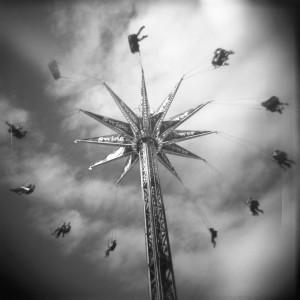TW Column by Judith A. Ross
In early December, I met the photographer Meg Birnbaum for lunch at a crowded cafe in her hometown of Somerville, Massachusetts. Like the soft grays, blues, and sepia tones in many of her photographs, Birnbaum seems quiet. She’s small, and wearing a navy blue overcoat, she blended right in with the line at the counter. Yet as we sat down, her blue eyes gleamed behind green-rimmed glasses. Over soup and a sandwich, we had a lively chat about her work.

Her photo “Circle Swing” is from a series Birnbaum created between 2007 and 2009 called Corn Dogs and Blue Ribbons. For two summers, she attended fifteen fairs—from small 4H events to giant expos—in New York and New England.
She loved “any excuse to photograph animals and eat french fries,” Birnbaum notes, but the first summer, she didn’t talk to anybody.
“It was a good chance to get experience photographing people, because everyone was busy and having a good time,” she says. “And then in the second year, I talked to everybody I could.”
For Birnbaum, getting out from behind the lens to engage with her subjects was a big step forward. She didn’t suddenly become an extrovert, but during that second summer she pushed herself to approach people. She soon found that once she did, they were happy to talk with her. Being shy is a challenge for many creative people; it’s one I know well myself. But while the camera can become a shield, Birnbaum says it’s helping her to overcome her “long journey with shyness.”
In other images, she emphasizes the way performers put aside their inhibitions and worries about being judged. Titled person/persona, the series includes color photographs of actors, dancers, and performance artists. Birnbaum pairs portraits of her subjects in costume and normal dress, exploring how they create alter egos.
The idea was sparked by an article about a woman in her twenties who performed with snakes and did belly dancing. “At her young age, she was putting on productions of sideshow acts,” says Birnbaum. “I wanted to learn what she had that I didn’t.”
While photography was an early love, Birnbaum first went into graphic design on the advice of her parents. But after years of working as an art director for several magazines, her heart got the last word. “I was assigning a lot of photography,” she says. “I knew I could do something better.”
Then, two months before 9/11, she was laid off from her job at the American Prospect. “I got serious about my camera that summer,” Birnbaum notes.
In the decade since, she has exhibited her work in museums and galleries across the United States. In 2010, she had an exhibition at the Gallery Tanto Tempo in Kobe, Japan. Her work was also awarded Best in Show at the Plastic Fantastic Show, held at the Lightbox Photographic Gallery in Astoria, Oregon.
Birnbaum’s first darkroom was in the attic of her family’s home in Rye, New York. The then fourteen-year-old shared it with her older sister.
“There was no ventilation and it was very hot. We’d be up there working in our underwear,” Birnbaum says with an impish smile. Her early photos were of the family dog and flora and fauna from a nearby pond.
Now in her fifties—and in a new millennium of digital cameras—Birnbaum still uses film and makes images in a darkroom. She often shoots that film with classic Holga and Diana cameras. These plastic cameras, which have few controls, “turned my view of what photography can be upside down,” she says. The resulting work has an old-fashioned feel.
Yet Birnbaum herself isn’t trapped by the past. All the subjects of her new portraits have told her that “performing changed their lives,” she says. “I’m starting to realize how much photography has changed mine.”
For more information, see Meg Birnbaum's website.
 Judith A. Ross is a contributing writer for Talking Writing. Her Talking Art column regularly appears in TW.
Judith A. Ross is a contributing writer for Talking Writing. Her Talking Art column regularly appears in TW.
While she has succumbed to the demon of shyness in the past, Judith is currently working hard to project her own clear and unique voice as a writer.
This piece has been slightly updated since its original appearance in the January 2011 issue of Talking Writing.

